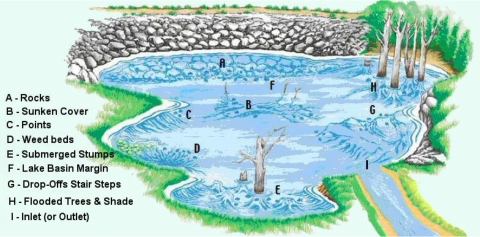Where to fish on Freshwater Lakes & Ponds
Ponds and lakes are quiet, shallow bodies of water that allow enough sunlight to reach their bottom. The sunlight supports the growth of rooted plants from shore to shore. Pond plants grow fully underwater or could have some parts above the water. Some plants can grow next to the pond edge. Plants produce food for a large variety of animal including fish and cover for fish to hide. Rock formations, docks and other shoreline structures also provide shelter, shade and protection for fish. Wind and streams carry in eggs, seeds, and organisms that build up into a variety of life forms.
Fish are looking for places with plenty of food. Any prey fish activity shows you fishing hotspots. Fish watch for hatching insects and other aquatic critters that live on and around lily pads. Minnows jumping above the surface are trying to escape to be eaten by larger fish. Small fish will attract larger fish to feed on them. If you see many small fish in the shallows look for larger fish, they are very close. Spreading rings across the surface or other signs of feeding fish could mean that bluegill or panfish are feeding on insects. A splash in the shallow water show you the place where a largemouth bass hunting for a bluegill. To catch a fish, the best is to use bait that looks or smells like a fish’s preferable natural food.
|
Lake Pond Fishing River Stream Fishing Bays & Estuaries Fishing Surf & Coastal Shore Fishing Deap Sea Fishing |
Lakes and ponds are divided into three different “zones” which are usually determined by depth and distance from the shoreline. The highest zone near the shore of a lake or pond is full of vegetation and animals that are food for fish and other creatures. The near-surface open water is well-lighted and is dominated by phytoplankton and zooplankton, which is food for fish. A variety of freshwater fish like Largemouth Bass and Smallmouth Bass, Pike, Pickerel, Perch, panfish, Sunfish, Carp, Trout, even Salmon are in this zone. The deep-water part of the lake/pond is very cold and pure on light.
Water temperature of ponds and lakes is quite even from top to bottom and changes seasonally. During the summer, the temperature can range from 4° C near the bottom to 22° C at the top. During the winter, the temperature at the bottom can be 4° C while the top is 0° C. Wind makes a little wave action in the water body, and the pond bottom is typically muddy.
Fish may scour the bottom, hunt near surface or swim anywhere between. Spawning brings fish together in one place. Their need for cover attracts them to structures such as rocks, logs and plants. Their need for suitable temperatures and oxygen levels keep them moving.
| You can fish in shallow or deep water, in open water or near natural or man-made structures, from the shore or from a boat. Any pond or lake structures like inlet created by a brook or spring, rock formations, reeds and weeds, holes and dams, islands, points, docks and overhanging banks, lily pads, natural objects are all the best places for fishing. Fish most of the time is looking for food or hiding in shoreline structures. They like cover, which hides them from their natural enemies. |

|
In a lake or pond, fish have to move around to find food. You have to decide if you’re going to fish where the fish are hiding or where the fish are feeding. Hiding places include undercuts in the banks, eddies, sunken trees and overhanging trees and bushes. Places that provide protection from the current and above-water predators. Feeding places include the outside of bends, merging currents, drop-offs, feeder brooks and springs. Places where the current slows down and food collects or sinks.
Fish use shelter as protection from predators and stay invisible before ambushing prey. Weeds, docks, brush, rocks and logs all provide cover that can hide or protect the fish. Shade makes the fish less visible and more protective. Look under piers, bridges, overhanging trees, cliffs or swimming platforms. Rocks provide fish with shelter, food and a possible place to mate. Rocks that are in deeper water or on the edge of deeper water provide an even better place to fish.
Back to top
All natural lakes have inlets and outlets for the water feed by a river or a stream. Wherever there is incoming or outgoing water, there's usually a lot of food, and where the food is, there is a fish. An inside turn with the shallow water is a small inlet that cuts into the shore and create break line, that attract a fish. Coves have more shoreline, more shallows and more protection. Smaller fish swim around the cove for plant food and bait fish, and game fish early in the morning or late at night came in to hunt for both bait fish and small fish.
Look for weed beds that lead to deeper water and create a break line. Weeds usually grow near the bank, fallen trees lean above the water, boat docks, swimming platform, flooded limber reaches above the water’s surface and loose rock often line shorelines. Look for sunken weed beds also in deep, open water. A point extends out from the shoreline and slopes gradually down and into deeper water are very good place. A break line created from sloping-out formation of a point draws fish from deeper water to shallow water to search for the food.
Underwater rocks and sunken logs, as well as fish shelters of sticks, brush or old trees are good covers that cannot be seen. Some fish spend most of their lives near cover; others move out to feed and come back to hide. These sunken bodies of land create a break line, when the land slopes gradually down and into deeper water. Water runs around sunken islands, carrying aquatic animals and small plant food that float on the surface. A bank or shear cliff with an underwater shelf, crumbled-off rock at the underwater base of sharp cliffs are good places for deep-water fish looking for food or place for spawning.
Back to top
Sharp drop-offs in depth, spring hole locations, points, ridges and sandbars shape the beds of lakes and ponds are often attract a lot of fish, even more than flat or lightly sloping bottoms. Where the land points extend into a lake, an old river channel, path between flooded trees, underwater island created of a break in a wave outline, and the weed edge tells where the water is deeper and sunlight can penetrate to the bottom. You can find good places to fish from clues on land or in the water. Favorite places for hungry fish on the transition zones between different habitats, where one kind of habitat changes to another, like at the edge of a lake’s shoreline zone or edge of a weed beds.
The water near the shore always has a lot of structure and food for the fish. Bait fish come in looking for the plant food. Small game fish, such as crappies, sunfish, bluegill and perch, come in to hunt for the bait fish. Early morning or late night, when it is shadow and the water is cooler game fish will swim into the shallows to hunt for the bait fish and for the pan fish.
Stronger winds push bait fish closer to shore, so the big fish is coming closer to shore to feed. During a breezy day surface water is moving around the lake together with a surface food. Look for the drift lines and you'll find fish.
The water along the shore always provides a lot of structure and food. So it attracts fish. Bait fish come in for the plant food. Pan fish, such as crappies, sunfish, bluegill and perch, come in for the bait fish. Early in the morning – or late at night- game fish will swim into the shallows to sneak up on both the bait fish and the pan fish.
They build up a protective coloration which helps them to merge with environment they are swimming. Bass from light-bottomed lakes have quite light coloration; from dark bottoms fish will be much darker. Fish are creatures of habit. The same fish will usually be found around the same places, feeding with the almost same food. They swim but sooner or later get back to the same old place. Also the certain kinds of fish prefer exact environment where they like to live. Your job is to look for them in those places where they are likely to be found. Look for Smallmouths bass around rock formations, and fish deep. Fish deep holes during the day, then try near shore during the evening hours for Largemouthed bass. Rock Bass is often hiding afforded by another object next to docks, overhanging banks, lily pads, and rocks. Look for Pickerel and Pike near the cover provided by grass beds, lily pads, and sunken logs. Pan fish-sunfish, bluegills, crappies, rock bass, and perch usually approximately foot off the bottom.
Back to top


































